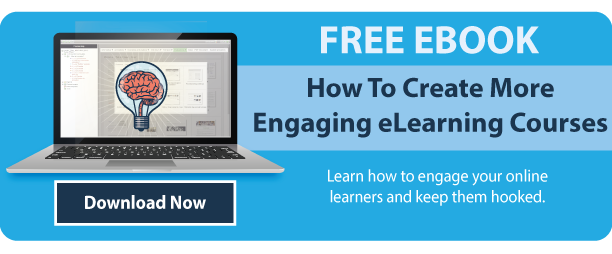You remember how words make you feel, not the words themselves. Maybe that doesn’t sound right to you but think of the first time you met your significant other. Do you remember what you said? What your significant other said? Probably not, but you do likely remember, in detail, how it made you feel. Now, consider what you could do if you could harness the power of that emotion and apply it to helping your eLearning audience remember and connect with facts. Facts may be more consistently accurate, but emotions are what our brains filter our experiences through and what we can recall most readily.
Taking your audience’s emotions into consideration is especially helpful when dealing with subject matter that is dry but important. For example, with corporate training, you might need to write up a section on which documents need to be filed for a new employee. Things don’t get much drier than talking about filing papers, but think of the massive headache new employees might have if their tax information isn’t filed and their paycheck is held up because of it. Telling your learners about the human side of what they’re learning and how it affects real people can make the difference between someone remembering long enough to apply the knowledge and someone just remembering for the length of the course.
Let’s go over a few ways you can win your learners' heart as well as their minds in eLearning:

1. Let the learner come first
It’s easy to jump into course planning by looking at the information that needs to be covered and then going about the business of how to most efficiently explain it, but this only focuses on what is being taught, not how it is going to be learned. If you put the learner before the learning you are much more likely to succeed in being effective. To do this, you need to understand who your audience is.
You can find this out by observing the audience, conducting surveys or perusing forums and message boards to see how your audience interacts with each other. If this seems unnecessary, just consider how quickly an older learner might get lost if you focus your examples on current pop stars or the latest social media trends. Your tone of voice is also important here. No matter if your audience is young or old, certain subject matter needs to be handled with more care and seriousness such as how to deal with grief or a job loss. Respect your learners and they will respect you and your course.
2. Use the power of hooks
Studies based on psychology professor Barbara Fredrickson’s research have shown that students are more likely to focus and perform better when they are put into a positive frame of mind before being asked to learn or take on a task [1]. You can engage your audiences this way by telling a story or giving an interesting statistic that will make them want to learn more. It hooks them early on, gives them a taste of your content and has them moving forward with increased interest. Think about how much the first paragraph or even the first sentence of a novel can affect your interest in continuing reading, and you will see why this hook is so important.
For instance, including visual metaphors as hooks can help grab eyeballs and trigger an emotional response in students since the beginning. Read more here.
3. Color your learner's world
When deciding on the importance of color in your eLearning course, consider what driving would be like if stop signs were black text on a gray background. How much more often do you think those signs would be missed? In the same way, color can be used to avoid the accident of a boring course by drawing learners’ attention.
Use cool colors for improved concentration and productivity, and warm colors for a more heated or lively response. Dark and more deeply saturated colors tend to correspond to darker emotions and lighter colors to lighter emotions. While you can use colors to your advantage and should use a reasonable variety, it is even more important to use color combinations that work together. No matter what you do, you do NOT want your course to start looking like a third grader’s coloring book. Using a variety of colors is all find and good, but use a critical eye when designing.
Read: 12 colours and the emotions they evoke
4. Make every image count
Pictures have great potential to enhance your eLearning course, but only if you know which images to use and how to use them. Putting multiple images on every page will have them coming off as filler without substance and become boring just the way large blocks of text can.
You should strive to have meaningful images placed in key positions. If you are writing an eLearning course on time management, it might be tempting to throw in pictures of clocks, but this means very little. Instead, think about the emotion you are trying to convey and get an image that depicts that. For example, a woman holding her head as she stares down at a mountain of paperwork will help your learners connect with how they feel when they are in that same situation, highlighting how much they need a time management course.
Or suppose you are creating a course to explain what constitutes bribery and the risks facing your organisation. Instead of using cliché and boring images (like image A), you can instead include one that can help your learners connect with and reflect on what might happen if they face a similar situation ( like image B).

5. Get them involved
Periodically making your audience apply their knowledge in teamwork or tests gives them the incentive to pay attention. Whether there is a leader or not to a course, creating a course that requires some collaboration is a good way to keep students engaged. Interaction is imperative in breaking up massive blocks of information that students will be far too tempted to skim over and not really process.
Idea: Include practice exercises that allow learners to organize steps of a procedure in the correct order, or a Hot Spot interaction that encourages learners to identify the part of an engine, or even include a simple discovery scenario about avoidable workplace safety hazards. All these can help you get your audience emotionally involved in the learning experience.

6. Ask them questions
While just presenting parragraphs of information can be valid to an extent, it is often far more likely for learners to remember things when they are asked to participate by answering questions. However, the same way images are not all equal, neither are all questions. Minimally, you should strive to ask questions that are open-ended and can’t be answered with “yes” or “no.” To make the questions even stronger, pose problems whose answers can’t be found within the course alone. Ask higher-order questions like "how," "why" and "what if" to make the learners reflect and ponder on their learning and apply it. For instance, ask why a character feels a certain way or if the learner would feel the same and why or how they would do things differently.
Read: How to Make Your eLearning Courses More Challenging
Elearning is likely to become increasingly important as people lead busier lives that do not provide enough money or time to complete traditional learning. Improving the way students can interact and engage is what will make eLearning more valuable and viable as a replacement for physically attending a course. Focusing your efforts as a designer to improving your audience’s experience will not only further your field, but provide quality training to many people who could not have it otherwise.
REFERENCES:
1.Fredrickson, Barbara. Are You Getting Enough Positivity in Your Diet? June 21, 2011 https://greatergood.berkeley.edu/article/item/are_you_getting_enough_positivity_in_your_diet
2. Quinn, N. Clark The Seven Step Program for eLearning Improvement. 2005



